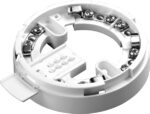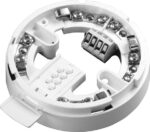Apollo 58000-305 Discovery CO & Heat Multisensor Detector
£51.64 (inc VAT: £61.97)
Summary
The Discovery CO/Heat Multisensor Detector contains a CO detection cell and a thermistor temperature sensor whose outputs are combined to give the final analogue value. The way in which the signals from the two sensors are combined depends on the response mode selected. The CO/Heat Multisensor detects the presence of carbon monoxide or heat or a combination of both.
The Multisensor construction is similar to that of a CO detector but uses a different lid in order to expose the thermistor to the surrounding air.
The signals from the CO sensing cell and the thermistor are independent and represent the amount of CO or the temperature present in the vicinity of the detector.
When the detector is used in heat only mode (Mode 5) it operates as an A1R rate-of-rise heat detector with a static threshold of 58°C.
About Apollo Discovery
Discovery® is a range of high-specification, analogue addressable fire detectors and alarm devices. Discovery detectors offer effective false alarm management by a combination of EN 54 approved operating modes and sophisticated algorithms.
Drift compensation further reduces the likelihood of false alarms caused by a build-up of dust in the sensing chamber.
In addition to the familiar smoke and heat detectors, the Discovery range features two multisensor detectors. One is an optical/heat multisensor which can be used to protect against many types of fire risk. The other is a carbon monoxide/heat multisensor which protects against both smouldering fires and those generating heat.
Operation
Discovery detectors are designed to be operated with purpose-designed control and indicating equipment that makes full use of their features. Discovery can, however, be connected to any fire control panel which can operate existing ranges of Apollo analogue addressable detectors with the previously noted rule, that the control and indicating equipment must not have a drift algorithm operating on Discovery devices. Contact the fire control panel manufacturer for guidance.
Device Addressing
- Mode 1 has very high sensitivity to carbon monoxide combined with moderate sensitivity to heat. This gives a high overall sensitivity to both smouldering and flaming fires.
- Mode 2 is set to report the presence of carbon monoxide only.
- Mode 3 has moderate sensitivity to carbon monoxide combined with moderate sensitivity to heat and is used for general applications.
- Mode 4 has lower than normal carbon monoxide sensitivity combined with moderate heat sensitivity making it suitable to areas where a certain amount of carbon monoxide might be considered normal.
- Mode 5 has no response at all to carbon monoxide and acts as a rate-of-rise heat detector.
Communication
Discovery uses a digital communications protocol which has been developed from the XP95 protocol but differs in that it allows communication in three different modes: (Normal, Read and Write) to allow a more extensive exchange of information and commands than previous analogue addressable ranges. In addition, Discovery can store data in non-volatile memory.
The Normal mode is identical to the XP95 protocol with the exception that the five additional analogue value bits in the XP95 protocol extension have been re-defined so that the fire control panel is able to distinguish between Discovery and XP95 devices.
The Read mode is used to check information stored in the non-volatile memory of each detector. It is accessed by using a simple extension to the Normal mode communication method from the fire control panel to the detector.
In Write mode the fire control panel is able to write information to the detector by extending the communication method in the same way as in Read mode. During Read or Write modes a detector can signal an alarm by means of the alarm flag and alarm address bits.
Discovery detectors are compatible with XP95 and Soteria. It should be noted, however, that Discovery features will not be available when Discovery is used with XP95 fire control panels. Fire control panels with drift compensation algorithms should disable the algorithms when communicating with Discovery.
For fire control panels running CoreProtocol, please refer to the fire control panel manufacturer’s operating instructions.
Maintenance & Service
Detectors should be maintained according to BS 5839- or other locally applicable code. Test equipment can be ordered from Apollo for testing smoke and heat detectors.
Detectors should not be cleaned in the field except for careful removal of exterior dirt with a damp cloth. For cleaning and recalibration detectors should be returned to Apollo Fire Detectors or to the local distributor.
Key Features
- Responds to smouldering and flaming fires.
- Less susceptible to false alarms caused by steam and dust.
- Five response modes.
- Remote test feature.
Additional information
| Weight | 0.1 kg |
|---|---|
| Colour | |
| Detection Type | |
| Device Type | |
| Hazardous Applications | |
| Marine Applications | |
| Protocol | |
| System Type |
Related Products
-

Apollo XP95 Isolating Base
ApolloThe XP95 Isolating Base isolates short circuits in the addressable loop while allowing the associated detector to remain active.
-

Apollo XP95 Intelligent Deep Base
ApolloCompatible with all Apollo XP95 detectors, the Intelligent Deep Base has extra depth to allow cable-insertion through the side of the base.
-

Apollo XP95 Intelligent Mounting Base in White or Black
Apollo- XPERT Addressing.
- One way fit of detector.
- Locking feature to prevent unauthorised detector removal.
-

Apollo XP95 Intelligent Heater Base
ApolloThe Intelligent Heater Base protects your Apollo XP95 detectors from environmental factors like icing and condensation.







